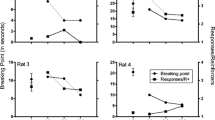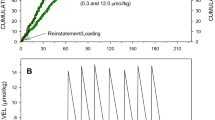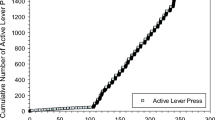Abstract
The effects of nine drugs were studied in rats responding under either fixed-ratio 30 (FR-30) or fixed-interval 2-min (FI-2) schedules of food presentation. All the drugs decreased average rates of responding under both schedules in a dose-related manner, with apomorphine and clonidine being the most potent and caffeine the least potent.d-Amphetamine was about three times more potent thanl-amphetamine in decreasing responding under the FR schedule, while the two isomers were equipotent in reducing the average response rates under the FI schedule. A 10 mg/kg dose of fenfluramine decreased responding for two to three days after administration, but this treatment did not produce long-lasting changes in control performance or in the effects of the serotonergic drugs quizapine andd-paramethoxyamphetamine. The effects of the drugs on the local rates of responding during the FI may be divided into three categories: (1) those drugs that increased low rates of responding and decreased high rates of responding (rate-dependent effects) at dosages that did not markedly decrease the average response rates (d-amphetamine, methylphenidate, and cocaine); (2) those that produced rate-dependent effects only at dosages that markedly reduced average response rates (fenfluramine, quipazine, and clonidine); and (3) those that did not produce clear rate-dependent effects at any dose tested (l-amphetamine, apomorphine, and caffeine). These behavioral results are discussed in relation to their known biochemical effects on brain catecholamine and serotonin systems.
Similar content being viewed by others
References
Branch, M. N., Gollub, L. R.: A detailed analysis of the effects ofd-amphetamine on behavior under fixed-interval schedules. J. Exp. Anal. Behav.21, 519–539 (1974)
Breese, G. R., Cooper, B. R., Hollister, A. S.: Involvement of brain monoamines in the stimulant and paradoxical inhibitory effects of methylphenidate. Psychopharmacologia (Berl.)44, 5–10 (1975)
Bunney, B. S., Walters, J. R., Kuhar, M. J., Roth, R. H., Aghajanian, G. K.:d- andl-amphetamine stereoisomers: comparative potencies in affecting the firing of central dopaminergic and noradrenergic neurons. Psychopharmacol. Commun.1, 177–190 (1975)
Clark, F. C., Steele, B. J.: Effects ofd-amphetamine on performance under a multiple schedule of reinforcement in the rat. Psychopharmacologia (Berl.)9, 157–169 (1966)
Clineschmidt, B. V., Totaro, J. A., McGriffin, J. C., Pflueger, A. B.: Fenfluramine: long term reduction in brain serotonin (5-hydroxytryptamine). Eur. J. Pharmacol.35, 211–214 (1976)
Couet, D. H., Iwatsubo, K.: Mechanisms of tolerance to and dependence on narcotic analgesic drugs. Annu. Rev. Pharmacol.15, 49–71 (1975)
Davis, T. R. A., Kensler, C. J., Dews, P. B.: Comparison of behavioral effects of nicotine,d-amphetamine, caffeine and dimethylheptyl tetrahydrocannabinol in squirrel monkeys. Psychopharmacologia (Berl.)32, 51–65 (1973)
Dews, P. B.: A behavioral effect of amobarbital. Naunyn Schmiedebergs Arch. Pharmacol.248, 296–307 (1964)
Ferris, R. M., Rang, F. L. M., Maxwell, R. A.: A comparison of the capacities of isomers of amphetamine, deoxypipradol and methylphenidate to inhibit the uptake of tritiated catecholamines into rat cerebral cortex slices, synaptosomal preparations, hypothalamus and striatum and into adrenergic nerves of rabbit aorta. J. Pharmacol. Exp. Ther.181, 407–416 (1972)
Ferster, C. B., Skinner, B. F.: Schedules of reinforcement. New York: Appleton-Century-Crofts 1957
Geyer, M. A., Dawsey, W. J., Mandell, A. J.: Differential effects of caffeine,d-amphetamine and methylphenidate on individual raphe cell fluorescence: a microspectrofluorimetric demonstration. Brain Res.85, 135–139 (1975)
Glowinski, J., Axelrod, J., Iverson, L. L.: Regional studies of catecholamines in the rat brain. IV. Effect of drugs on the disposition and metabolism of H3-norepinephrine and H3-dopamine. J. Pharmacol. Exp. Ther.153, 30–41 (1966)
Gonzales, F. A., Byrd, L. D.: Mathematics underlying the ratedependency hypothesis. Science195, 546–550 (1977)
Graeff, F. G., De Oliveira, L.: Influence of response topography on the effect of apomorphine and amphetamine on operant behaviour of pigeons. Psychopharmacologia (Berl.)41, 127–132 (1975)
Green, A. R., Youdin, M. B. H., Grahame-Smith, D. G.: Quipazine: its effect on rat brain 5-hydroxytryptamine metabolism, monoamine oxidase activity and behavior. Neuropharmacology15, 173–179 (1976)
Harris, R. A., Snell, D. B., Loh, H. H.: Effects ofd-amphetamine, monomethoxyamphetamines and hallucinogens on schedulecontrolled behavior. J. Pharmacol. Exp. Ther. (in press 1977)
Harvey, J. A., McMaster, S. E.: Fenfluramine: evidence for a neurotoxic action on midbrain and a long-term depletion of serotonin. Psychopharmacol. Commun.1, 217–228 (1975)
Janssen, P. A. J., Niemegeers, C. J. E., Schellekens, K. H. L.: Is it possible to predict the clinical effects of neuroleptic drugs (major tranquilizers) from animal data? Arzneim. Forsch.15, 104–117 (1965)
Javoy, F., Agid, Y., Glowinski, J.: Oxotremorine and atropine-induced changes of dopamine metabolism in the rat striatum. J. Pharm. Pharmacol.27, 677–681 (1975)
Jones, C. N., Hill, H. F., Harris, R. T.: Discriminative response control byd-amphetamine and related compounds in the rat. Psychopharmacologia (Berl.)36, 347–356 (1974)
Kannengiesser, M., Hunt, P. F., Raynaud, J.: Comparative action of fenfluramine on the uptake and release of serotonin and dopamine. Eur. J. Pharmacol.35, 35–43 (1976)
Leander, J. D.: Rate-dependent effects of drugs. II. Effects of some major tranquilizers on multiple fixed-ratio, fixed-interval schedule performance. J. Pharmacol. Exp. Ther.193, 689–700 (1975)
McMillan, D. E., Leander, J. D.: Effects of drugs on schedule-controlled behavior. In: Behavioral pharmacology, S. D. Glick and J. Goldfarb, eds., pp. 85–139. St. Louis: C. V. Mosby 1976
Opitz, K.: Anorexigene Phenylalkylamine und Serotonin-Stoffwechsel. Naunyn Schmiedeberg's Arch. Pharmacol.259, 56–65 (1967)
Owen, J. F.: The influence ofdl-, d- andl-amphetamine andd-methamphetamine on a fixed-ratio schedule. J. Exp. Anal. Behav.3, 293–310 (1960)
Peterson, D. W., Sparber, S. B.: Increased fixed-ratio performance and differentiald- andl-amphetamine action following norepinephrine depletion by intraventricular 6-hydroxydopamine. J. Pharmacol. Exp. Ther.191, 349–357 (1974)
Phillips, A. G., Brooke, S. M., Fibiger, H. C.: Effects of amphetamine isomers and neuroleptics on self-stimulation from the nucleus accumbens and dorsal noradrenergic bundle. Brain Res.85, 13–22 (1975)
Rodriguez, R., Rojas-Ramirez, J. A., Drucker-Colin, R. R.: Serotonin-like actions of quipazine on the central nervous system. Eur. J. Pharmacol.24, 164–171 (1973)
Sanger, D. J., Blackman, D. E.: Rate-dependent effects of drugs: a review of the literature. Pharmacol. Biochem. Behav.4, 73–83 (1976)
Segal, D. S.: Behavioral characterization ofd- andl-amphetamine: neurochemical implications. Science190, 475–477 (1975)
Shore, P. A.: Actions of amfonelic acid and other non-amphetamine stimulants on the dopamine neuron. J. Pharm. Pharmacol.28, 855–857 (1976)
Simpson, L. L.: Blood pressure and heart rate responses evoked byd- andl-amphetamine in the pithed rat preparation. J. Pharmacol. Exp. Ther.193, 149–159 (1975)
Smith, C. B.: Effects ofd-amphetamine upon operant behavior of pigeons: enhancement by reserpine. J. Pharmacol. Exp. Ther.146, 167–179 (1964)
Stein, L., Wise, C. D., Belluzzi, D.: Effects of benzodiazepines on central serotonergic mechanisms. In: Mechanism of action of benzodiazepines, E. Costa and P. Greengard, eds., pp. 29–44. New York. Raven 1975
Taylor, K. M., Snyder, S. H.: Amphetamine: differentiation byd andl isomers of behavior involving brain norepinephrine or dopamine. Science168, 1487–1489 (1970)
Tessel, R. E., Woods, J. H.: Fenfluramine and N-ethyl amphetamine comparison of the reinforcing and rate-decreasing actions in the rhesus monkey. Psychopharmacologia (Berl.)43, 239–244 (1975)
Tilson, H. A., Sparber, S. B.: The effects ofd- andl-amphetamine on fixed-interval and fixed-ratio behavior in tolerant and nontolerant rats. J. Pharmacol. Exp. Ther.187, 372–379 (1973)
Tseng, L. F., Menon, M. K., Loh, H. H.: Comparative actions of monomethoxy-amphetamines on the release and reuptake of biogenic amines in brain tissue. J. Pharmacol. Exp. Ther.197, 263–271 (1976)
Author information
Authors and Affiliations
Rights and permissions
About this article
Cite this article
Harris, R.A., Snell, D. & Loh, H.H. Effects of stimulants, anorectics, and related drugs on schedule-controlled behavior. Psychopharmacology 56, 49–55 (1978). https://doi.org/10.1007/BF00571408
Received:
Issue Date:
DOI: https://doi.org/10.1007/BF00571408




